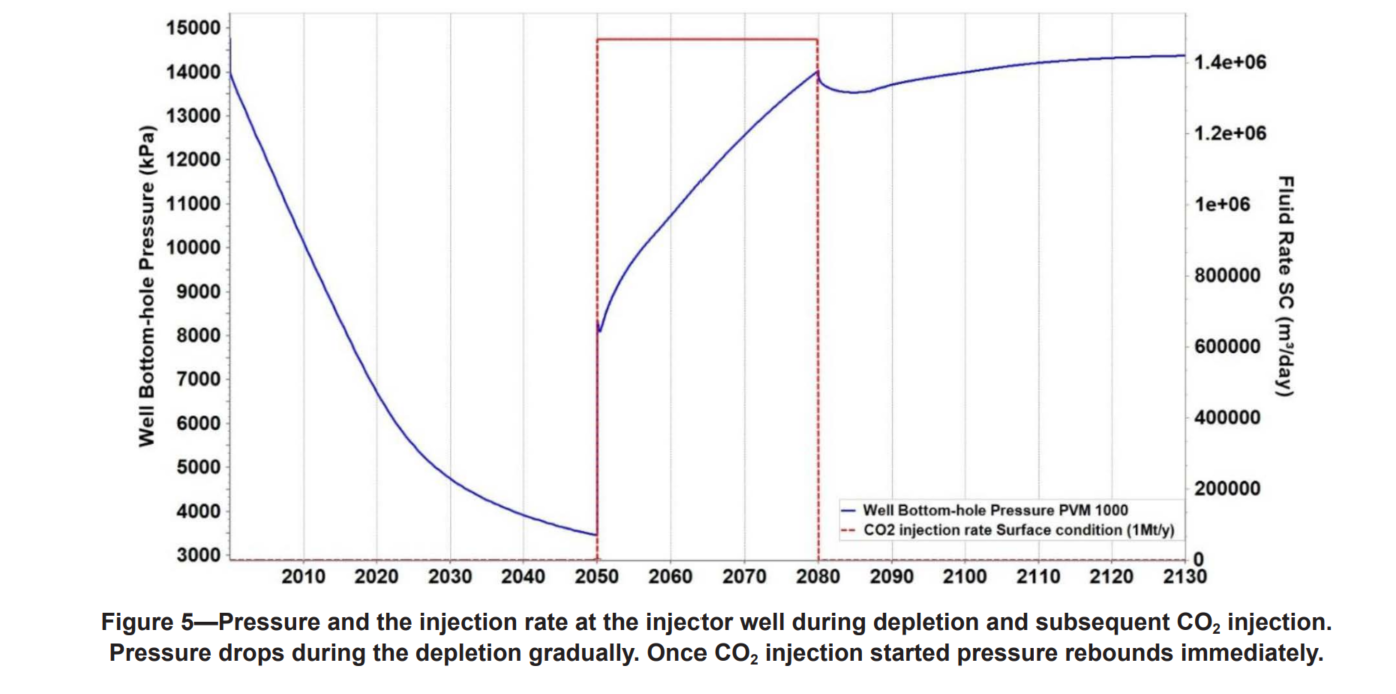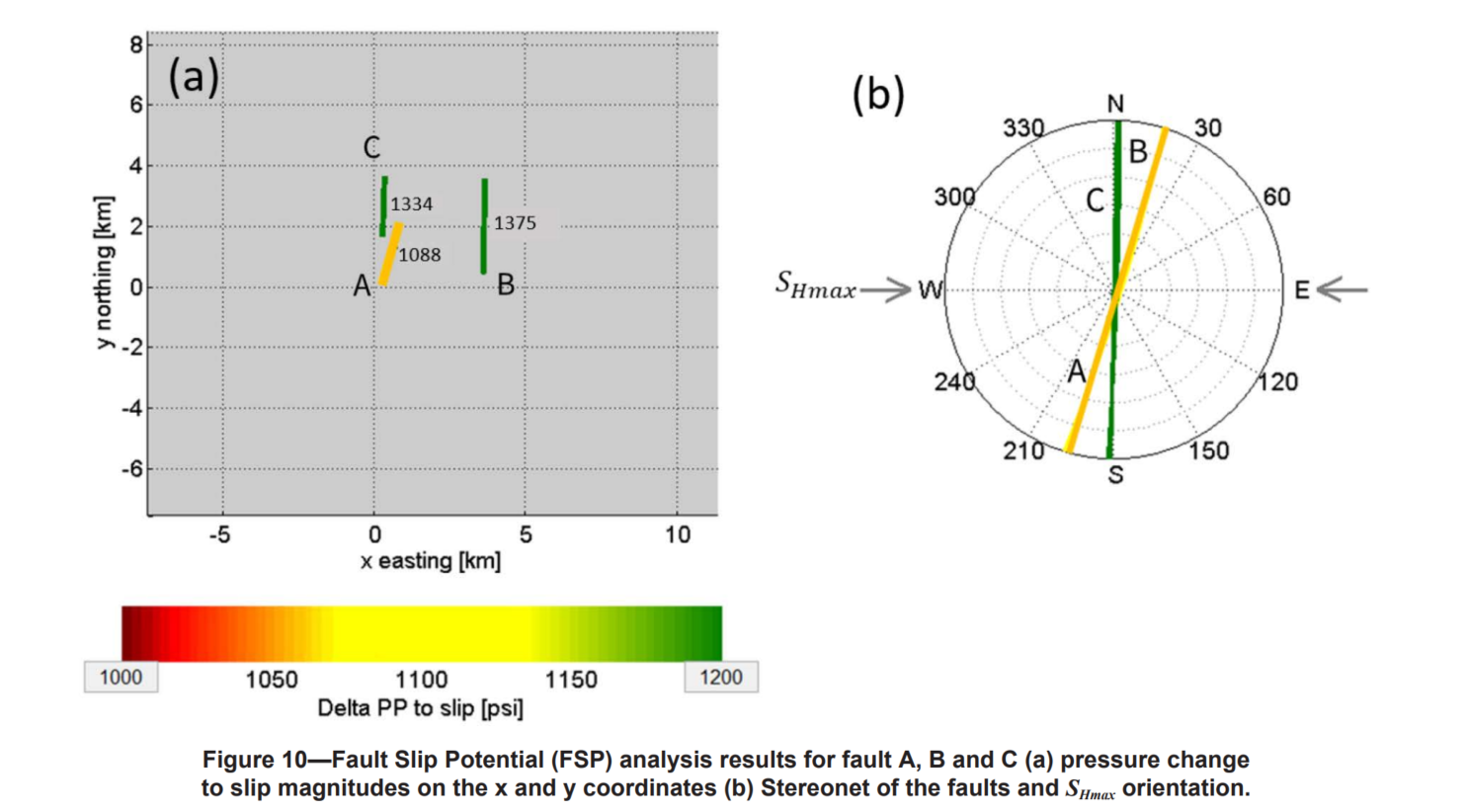SPE-218908-MS Numerical Simulation of CO2 Storage in the Soft Sediments of Depleted Reservoirs in the Gulf of Mexico
枯竭的油气藏是大规模地质CO2储存最受欢迎的地层之一。尽管对许多这些领域的地质结构和物理性质进行了广泛的研究和表征,但与储层流动和力学性质相关的现场和岩心样本数据的缺乏阻碍了CO2储存的评估和模拟,特别是在海上区域。
在本研究中,我们开发了一个耦合流-地质力学数值模型,以评估在墨西哥湾西三角油田的软沉积物中储存CO2的潜力。储层岩石的孔弹性参数在实验室中进行了测量,基于可用的地震和测井数据建立了储层的地质模型。模拟了储层枯竭过程以考虑孔隙度降低和渗透率变化的影响。在边界处使用了孔隙体积乘数以在枯竭后达到储层中的真实压力。使用修改后的CamClay模型作为力学破坏标准,以追踪孔隙度和地层沉降。
结果表明,在枯竭期间孔隙度有所降低,然后在CO2注入期间增加。然而,在注入过程完成后,孔隙度并未完全恢复。储层顶部的最大沉降在枯竭完成后几乎达到了24厘米。断层带的压力积累根据断层靠近注入井的距离、断层倾角、倾角方向和CO2注入速率而有所不同。使用断层滑移潜力(FSP)进行的敏感性分析表明,诸如SHmax方向、摩擦系数和断层倾角等各种地质力学参数显著影响了断层滑移的概率。假设断层是封闭的,那么在储层体积中滑动主要断层所需的压力扰动低于CO2注入后计算出的压力积累。
其他两个主要断层在任何情况下都不会被预测为有激活的潜力。因此,建议进行额外的力学表征,特别是关注原位应力方向和断层的透水性,作为进一步的工作。这一预防措施旨在减少在注入阶段或注入后断层激活的风险。
CMG软件应用情况:
在这项研究中,CMG软件的GEM模拟器被用来解决耦合的流体流动和地质力学方程组。在PETREL中建立的地质模型被导入GEM。模型的尺寸为3.64×3.93公里,平均倾角为3.39°,朝向东北。由于储层地质的非均质性以及研究区域内存在三条主要断层,因此最初导入了网格。
随后,将孔隙度、渗透率、泥岩体积(VSH)和净与毛比等储层属性单独添加到CMG模型中。之后,将井纳入模型。在PETREL中创建的原始井超出了研究区域,因此不适合在CMG模型中使用。在砂岩沿井建立了射孔。此外,修正了网格重叠,以防止断层带内的收敛误差。根据1950年至2022年的现场测量记录,储层温度在56至58°C之间波动。储层的垂直渗透率(kv)假设为水平渗透率(kh)的0.1倍,这个值来源于测井数据。



Abstract
Depleted oil and gas reservoirs are among the most popular formations for large-scale geologic CO2 storage. While extensive research and characterization have been conducted on the geological structure and physical properties of many of these fields, the lack of field and core sample data related to reservoir flow and mechanical properties has hindered the assessment and modeling of CO2 storage, especially in offshore areas. In this study, we developed a coupled flow-geomechanical numerical model to evaluate the potential for storing CO2 in the soft sediments of the West Delta field of the Gulf of Mexico. The poroelastic parameters of the reservoir rocks were measured in the laboratory and the geological model of the reservoir was constructed based on the available seismic and well logs. The process of reservoir depletion was simulated to consider the effect of porosity reduction and permeability change. Pore volume multipliers were employed at the boundary to reach realistic pressure in the reservoir after depletion. A modified CamClay model was used as the mechanical failure criterion to trace the porosity and formation subsidence. The results showed that the porosity reduced somewhat during the depletion and then increased during the CO2 injection. The porosity, however, did not fully recover after the injection process was completed. The maximum subsidence of the storage formation top reached almost 24 cm at the well location once the depletion completed. The pressure buildup at fault zones varied based on the vicinity of faults to the injection well, fault dip, dip direction, and CO2 injection rate. Sensitivity analysis using Fault Slip Potential (FSP) showed that various geomechanical parameters such as SHmax orientation, friction coefficient and dip of the fault influenced the probability of fault slip markedly. Assuming that faults are sealed, the pressure perturbation required to slip one of the major faults in the reservoir volume studied was lower than the calculated pressure buildup after the CO2 injection. The other two major faults are not predicted to have the potential for activation in any scenario. Therefore, it is advisable to conduct additional mechanical characterization particularly focusing on in-situ stress orientation and the transmissibility of faults as further work. This precautionary measure aims to mitigate the risk of fault activation during or after the injection phase.
作者单位
斯坦福大学能源资源工程系
